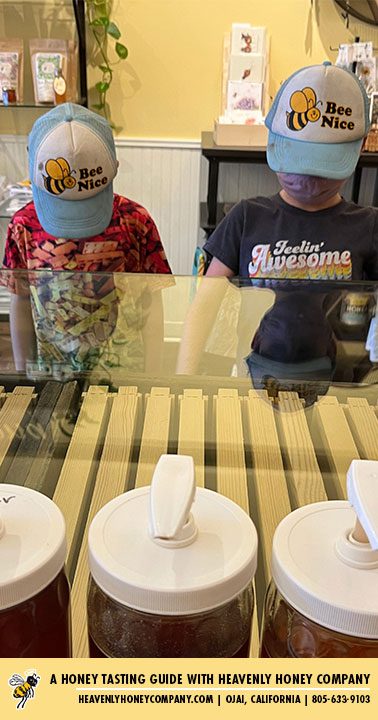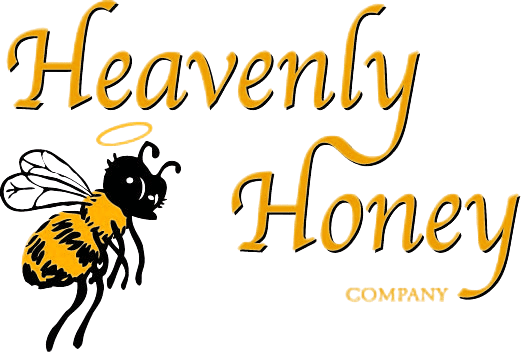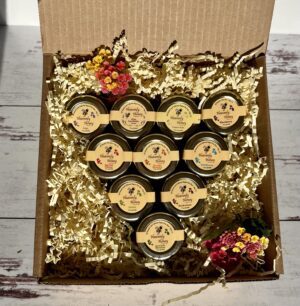
As the family behind the Heavenly Honey Company, we are more than just beekeepers – we are custodians of a legacy. Our 2nd generation family-owned honey farm is a testament to the harmonious dance of bees and flowers, and we take immense pride in sharing this sweetness with the world. Today, we invite you on an exploration of tastes as we delve into the art of honey tasting.
Join Our Honey Tasting Adventure! 🍯🐝
Before taking you on a journey through the world of honey tasting, the true adventure lies in experiencing these unique honey flavors firsthand. With an array of honey varieties to choose from, each with its distinct flavor profile, there’s a sweet symphony waiting for your palate.
From the gentle floral sweetness of Sage honey to the rich, robust flavor of Buckwheat honey, our unfiltered honey varieties capture the essence of nature, one drop at a time. You are just a click away from experiencing this sensory exploration.
Embark on a honey tasting adventure with Heavenly Honey Company. There’s a world of sweet, golden delight just waiting for you!
-
 Honey Tasting In a Box$ 58.00
Honey Tasting In a Box$ 58.00
Now let’s jump into The Honey Tasting Guide!
The Intricate Art of Honey Tasting
Honey tasting is not merely discerning sweetness; it is an adventure of senses, an exploration of nature’s intricate palette. Each drop of honey carries an essence of the nectar it originated from, opening up a tapestry of flavors — from the burst of wildflowers under the summer sun to the subtle earthiness of a prairie untouched by time.
A Sensory Journey into Honey Tasting
As we begin our honey-tasting journey, let’s first look at how to appreciate honey in all its glory. The appearance of honey — its color and texture — tells a story about the nectar’s origin. The taste unfolds this story on your palate.
Unveiling Our Unfiltered Honey Varieties
Our bees are tireless workers, flying miles to collect nectar and produce unfiltered honey of unmatched quality. Let us introduce you to our various offerings and their intricate flavor profiles.
Alfalfa Honey
Our Pure & Raw Alfalfa honey comes from the Antelope Valley and Inland Empire Valley, where many alfalfa hay farms exist. This honey is very similar to our Buckwheat honey, with just a bit more caramel flavors. The Alfalfa honey often surprises people with how good it is!
The Alfalfa honey compares in flavor to the Buckwheat honey. It will hold up well to heat in cooking, so it lends itself well to use as a substitute for brown sugar in your recipes. Alfalfa honey can also be used as a syrup and brown sugar substitute for your oatmeal. In our hone, we especially love it in our morning coffee as it has a subtle raw sugar quality
Avocado Blossom Honey
Our Avocado Blossom honey comes out of the Temecula Valley. This honey is the “Big Daddy” of our honey lineup. With its pleasantly pungent molasses-like flavor, this honey is a stand-alone varietal.
Avocado honey can substitute molasses in recipes, pairing well with ginger in ginger cookies, for example, or even in a hearty BBQ sauce. This honey will also stand up to a strong cheese on a cheese platter and leave your guests talking about your good taste in unique honey!
Buckwheat Honey
Our Raw Buckwheat honey comes from the mountains of the Angeles National Forest from California wild Buckwheat. Although related, this plant differs from the cultivated buckwheat plants grown for buckwheat flour and grain.
Our Buckwheat honey has a wonderfully smooth “round” flavor with no sharp edges. Although it is a bit stronger in flavor than any of our lighter-in-color honey, it still is not strong. The best way to describe its flavor is “soothing.”
Buckwheat honey has MANY uses; it can replace brown sugar in a recipe and is also a great substitution for syrup, adding richness to your pancakes, waffles, and French toast that you cannot get with typical syrups. This honey also works well as a skin soothing and smoothing facial! We call it the “Manuka honey of California!” Do you like hot toddies? This honey pairs perfectly with whisky!
Clover Honey
For the first time in the history of our business, our Raw Clover honey comes from California. California Clover is a natural growing wild plant that is not prolific in California. This is a very special honey in our opinion!
The bees love the clover flowers, and we love the honey produced from them! When clover honey is pure, it tastes like cinnamon, and nutmeg is added. That is a very special quality of this honey; its comforting spices are good for the senses!
Chrystalled Sunflower Honey
Our raw Chrystalled Sunflower honey comes from the plains of South Dakota, where sunflowers grow for as far as the eye can see. When we pour this honey into the jars, we add a very small honey chrystal into this delicately flavored honey. Over time, the honey turns to a soft butter consistency.
This doesn’t change the honey’s flavor; it makes it easily spreadable for the perfect pb&j sandwich. Try some today; you won’t be sorry!
Lavender Infused Honey
Our Lavender Infused Honey combines two wonderful gifts of Ojai, pure sage honey and organic lavender from the Ojai Lavender Farm in Upper Ojai. Creating our Lavender Infused Honey takes many months , and we must watch the honey carefully, tasting it often to be sure the infusion is not getting too strong.
The final result of all this work is so very yummy! Through the infusion, the honey becomes sweeter, almost like candy, with a subtle lavender essence on both the tongue and the nose. This is a very special honey, completely unique to Ojai, not to be found anywhere else. Made in small batches, it is very popular in our tasting room, so get your order in today!
Meadowfoam Honey
Our Meadowfoam honey is a very unique honey, to say the least! It comes from a spot in Oregon where this crop is grown for the cosmetic industry. The seeds are harvested from the plant, and the oils are extracted from the seeds for use in cosmetics. The bees help pollinate the flowers, so the growers get a LOT of seeds. In the process of pollination, the bees make this honey that tastes like toasted marshmallows or creme brûlée.
We love this honey on a peanut butter sandwich. Ever heard of a “Fluffernutter?” This honey is the fluff (marshmallow fluff) without the guilt! It is estimated that less than 6500 pounds of this honey is produced each year, making it a highly sought-after honey, and it can be challenging to find! Grab some today! As always, it is pure, raw, and all-natural goodness!
Orange Blossom Honey
Our raw Orange Blossom honey is made locally in California’s central and southern regions. Orange Blossom honey is a bit sweeter than the others, with a subtle scent of blooming orange blossoms in your nose. The honey itself does NOT taste like oranges. Orange Blossom honey is a great “multi-purpose” honey for your kitchen.
Orange Blossom honey lends itself well to use in coffee, tea, cereal, and even when boiling frozen peas – drop a spoon in the water as it boils, and you will have sweet peas! It is a wonderful replacement for white sugar. If you are having trouble picking which honey to buy, you can’t go wrong with this one; it is universally enjoyed.
Sage Honey
Our raw Sage honey comes right out of our very own Ojai Valley. This delicately sweet honey is made from the sagebrush plants, which is different from the sage we cook with, so there will be no herb flavor in this honey. Sage honey production is a challenge in the midst of the drought in California.
For the sagebrush to give the bees its nectar, the rains must come during a specific time, and the early spring temperatures must be just right. Some years we don’t get the rain, others we get the rain but not the warmth, and some years the stars align, all conditions are right, and then here comes the honey! We never know when this might happen, so when we get sage honey it is a gift from Mother Nature.
Wild Blackberry Honey
Our raw Wild Blackberry honey comes from blackberry brambles growing wild in the Salem area of Oregon. This honey is truly unique because it tastes just like blackberries! It isn’t often the honey tastes like the plant it came from.
This honey has a sharply sweet start with an undeniable blackberry jam finish; that made it a tasting room favorite as soon as we released it. Get some today; you will not be sorry! (Be sure to have some biscuits handy upon arrival!)
Wildflower Honey
Our raw Wildflower honey is made locally in the surrounding Ojai hills and valleys. Our Wildflower honey is different each year because of the different flowers blooming in the different micro-climates where the bees are kept.
Wildflower honey, by nature, has a more complex flavor profile, often with a more angular taste. This honey is more mid-range regarding flavor intensity but can still be used quite easily in teas and toast.
Step-By-Step Guide to Honey Tasting
Here’s a simple step-by-step guide to help you appreciate and enjoy the unique profiles of our unfiltered honey varieties.
Step 1: Observe the Honey
Before you taste the honey, look at it. The color and clarity of honey can give you an idea about its floral source. For instance, lighter honey is usually derived from flowers like Clover and alfalfa. In comparison, darker honey may come from buckwheat or wild blackberries.
Step 2: Smell the Honey
Honey carries the scent of the flowers, where bees forage for nectar. Take a moment to appreciate the aroma of the honey. It can range from subtly floral to richly fruity or even buttery.
Step 3: Taste the Honey
Now comes the moment you’ve been waiting for to taste honey! Take a small spoonful and let it dissolve slowly on your tongue. As it spreads, try to identify the different flavor notes. Is it purely sweet, or can you detect a hint of tanginess or bitterness? Some honey varieties might even have spicy or nutty undertones. Be sure to breathe through your nose while tasting, your nose plays a big part in your taste experience!
Step 4: Assess the Texture
As you savor the honey, also pay attention to its texture. Honey can range from creamy and smooth to slightly gritty. This has to do with the crystallization process, which can be affected by factors like the nectar source, storage conditions, and even the individual techniques of the bees.
Step 5: Note the Aftertaste
After swallowing the honey, pause for a moment to detect any aftertaste. Some honey finish cleanly, while others leave lingering flavors that can change your overall impression of the honey.
Step 6: Cleanse Your Palate
Before you move on to taste a different type of honey, cleanse your palate. This can be done by sipping warm water, eating neutral-flavored food like a plain cracker, or sipping on one of our custom blend loose-leaf organic teas. This ensures that the flavors of the previous honey don’t interfere with your next tasting experience.
Conclusion
At Heavenly Honey Company, our mission is to share the incredible journey of honey tasting. We’re excited for you to explore these distinct flavors and become a honey connoisseur. Our family legacy lives in each drop of honey, and we look forward to sharing our passion with you.
In tasting honey, you taste the dedication of our bees, the richness of our lands, and our family’s legacy. This isn’t just honey; it’s a sensory voyage that transcends sweetness and taps into the heart of nature itself. We hope you’ll enjoy this journey as much as we’ve enjoyed preparing it for you, and if you’re in California, feel free to stop by our Honey Tasting Room to get the full Honey Tasting Experience!
FAQ’s
What makes unfiltered honey different from regular honey?
Unfiltered honey is straight from the hive, containing all the pollen, enzymes, and other micronutrients that are usually filtered out during the honey processing. This gives unfiltered honey a richer flavor and higher nutritional value compared to regular, filtered honey.
Why does each type of honey taste different?
The taste of honey depends on the nectar source that bees collect from. Different flowers provide nectar with unique flavors, which translates into the diverse flavor profiles of our honey varieties.
Can I use any honey variety in cooking?
Yes, you can! Each honey variety has a unique flavor that can enhance different dishes. For example, Buckwheat honey works well in savory dishes because of its robust flavor, while Orange Blossom honey is excellent for baking or in tea because of its floral notes.
How should I store my honey?
Store honey at room temperature in a tightly sealed container. Honey is a natural preservative and doesn’t require refrigeration. In fact, cooler temperatures can lead to crystallization, although this doesn’t affect the honey’s quality or taste.
What do I do if my honey crystallizes?
If your container is glass, loosen the lid slightly and place in a saucepan with a couple inches of water in the bottom. Turn your stove burner on as LOW as it will go, you just want the water to get steamy – not bubbling or boiling. Keep an eye on your honey and remove it from the heat as soon as it’s back to liquid. Leave in the pan to cool off the burner. If you have a plastic container, place it in an empty bowl and set it on the dashboard of your car on a sunny day. Your car acts like an oven to warm the honey gently.


